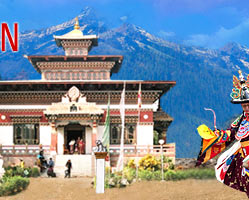National Flag of Bhutan is divided diagonally with a white dragon in the center of the flag. The dragon is snarling and clutches jewels in its claws. One half of the flag is orange representing the spiritual power in the country that is controlled chiefly by Drukpas monasteries and Buddhist religious practices. The other half of the flag is saffron yellow representing the temporal power in the country and the secular authority of the dynasty. Bhutan is a religious country with Buddhism as its official religion. Bhutanese people call their country as ‘Druk yul’ or ‘Land of the Thunder Dragon’. Bhutanese believe that thunder is actually the voices of the dragon roaring. Thus the dragon in the center of the flag or ‘Druk’ has deep association with the country itself
The jewels in dragon’s claws represent the wealth and prosperity of the nation. The snarling dragon represents the male and female deities who are always protecting the country, its King and the people from harm and are inimical to outside forces that are threatening them. In Bhutan, the democratic government shares its power with the King representing the monarchy. In the late 12th century and the beginning of 13th century, a monastery was set up in Bhutan, which was called the ‘Druk’ (meaning the ‘Thunder Dragon’) and the sect it represented was called ‘Drukpas’. Since then, dragon has become inseparable with Bhutan. The King, His Majesty Jigme Wanchuck, designed the first version of the national flag.
It appeared during the signing of the Indo-Bhutan Treaty of 1949. The flag was square, divided diagonally, with yellow in the upper hoist and red in the lower fly. The green dragon set diagonally at the centre of the flag was taken from the traditional depiction of the turquoise dragon ‘Yu Druk Ngonm’. Lharip Taw Taw, a court painter, embroidered on the original flag. In 1956, another flag was made for the royal tour, with the exception of the dragon, whose color was changed to white and the dragon was set straight. Copies of this flag were affixed to the saddles of every tenth pony in the convoy, while a larger flag, about 6 sq. feet was hoisted at the camps. This National Flag of Bhutan was interpreted as follows:
“The national flag is half yellow and half red. The yellow spreads from the summit to the base and forms the fluttering end. His Majesty, the Dharma King is the summit and root of the Drukpa Kagyud of the Palden Drukpa. As he wears the yellow robe [scarf], the yellow represents the being of His Majesty. The significance of red is that the Kingdom of Kagyud Palden Drukpa is governed from the foot of the Dharma King His Majesty consistent with dual monastic and civil systems, and therefore the country's entire borders and centre is consistent with the teachings (Dharma). The red and yellow fields are adjoined. The dragon spreads equally over them. This signifies that the people are united in oneness of speech and mind in upholding the Kingdom's interest. The dragon symbolizes that in the eyes of Palden Drukpa, there is no discrimination against people of any disposition, and that they are being governed toward peace and prosperity."
In the late 1950s, an official from India visited Bhutan and it was noted that Indian flag that had 2:3 size proportions was flying better than the square flag of the Bhutan. Thus, the national flag was redesigned to its present design based on the size of the Indian flag, which is 9 feet by 6 feet. The dragon was again embroidered diagonally along the color join, so that it would not seem as if the dragon is facing downwards when the flag flies. In late sixties, the red color was changed to orange to represent Buddhism.




